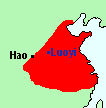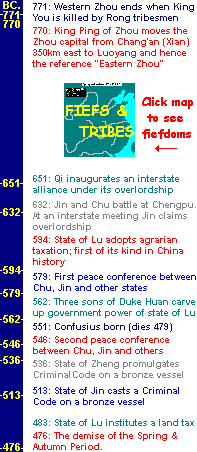
Spring
and Autumn
(770 - 476 BC.)
![]()
Previous Dynasty
 |
Spring
and Autumn |
Previous Dynasty |
 |
China's
first golden age expires when King You of Zhou is killed and his
successor, King Ping, moves the capital east to Luoyi. Hence the use of the term
"Eastern Zhou" for this period. Historians divide it into two
parts:
"Spring and Autumn" (
why?) and "Warring States". The first
clear signs of an emerging united "China" appear.
In the Spring and Autumn period Zhou's power declines, the fiefs assume the character of independent "states" and, in the end, Zhou reigns -but no longer rules. |
|
|
Eastern Zhou |
|
Spring & Autumn Timeline: |
 |
|
Antiques and Anecdotes: |
| art picture |
| space |
| elsewhere in world |
| elsewhere picture |
| History: |
| Revolting against the Zhou court
in 771 BC, the marquis of Shen and the marquis of Ceng (today's Tangcheng,
Henan Province) ally with the nomadic Quanrong people and kill King You of
Zhou in the capital of Hao close to Chang'an (today's Xi'an). They then install Crown Prince
Yijiu as King Ping of Zhou.
The Tiny Beginnings of a United
"China" In return for his services Duke Xiang is made vassal lord of a fiefdom called Qin. It is the very same state of Qin that would grow strong and some 500 years later overrun Luoyang, end the Zhou dynasty, and 35 years afterwards for the first time unite China (Qin = Chin = China). From 170 to Only 7 Philosophy Other Signs Hinting at a United
"China" The End of Spring and Autumn Period -The
Great Wall ? Zhou's loss of power is finally and indisputably exposed when the loyal family-state of Jin is divided among three families without mandate from Zhou and when the loyal vassal of Qi is deposed by a coup d'etat. In both instances Zhou is clearly helpless to interfere and henceforth Zhou is relinquished to a purely ceremonial role. At this time, 476 BC, only seven major states remain and they now turn on each other for supremacy in the "Warring States Period". |